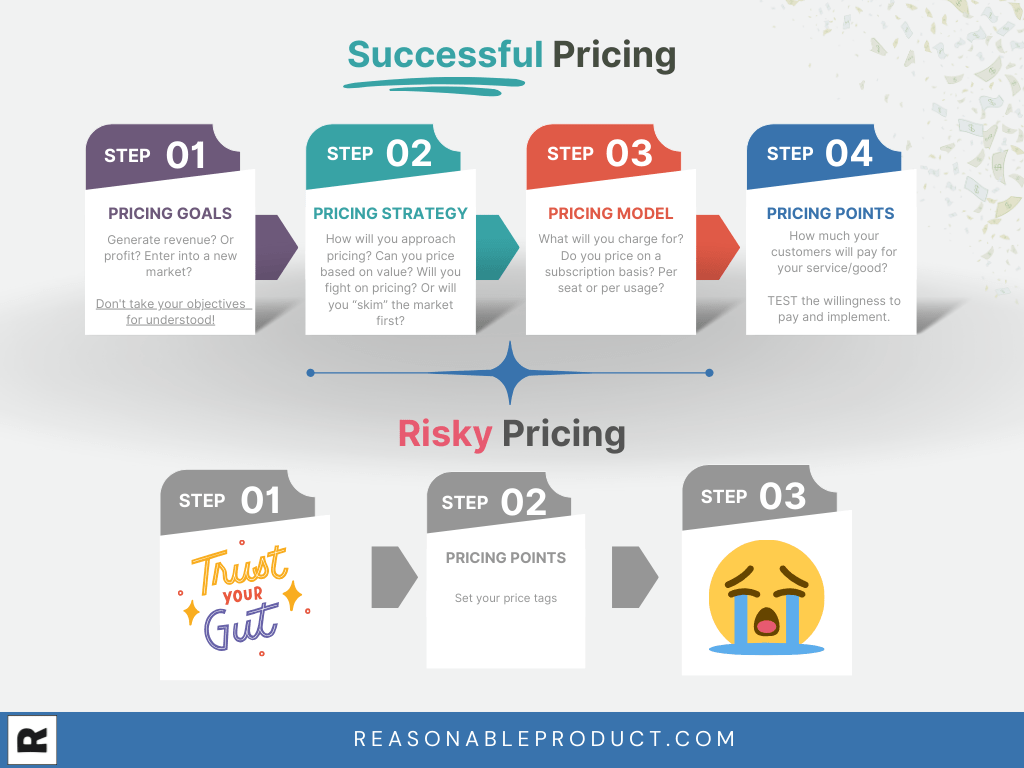Successful Pricing is a process, not a number
When it comes to pricing a new product or adjusting existing prices, many people face the same dilemma: Where do I start?
Most teams and executives tend to fixate on the “price tag” (i.e., “how much to charge”), which often results in either “price guessing” (picking a number that feels right) or relying on competitive pricing strategies. In both cases, you risk leaving money—and customers—on the table. Sound familiar?
Don’t worry, we’ve got you covered! With four simple steps, you can say goodbye to “copy-paste” and patchwork pricing, and finally set pricing that makes sense for your product or service.
A simple yet powerful process
While jumping straight to setting the price tag might seem more exciting than discussing strategies, successful pricing isn’t a quick fix. If you feel tempted to rush to the “pricing points drawing board” and throw around random numbers, take a step back and breathe!
Here’s why using a structured approach is essential:
- Reduced Risk of Discrepancy: There’s no universally “right” price, but there is a right price for your company. Starting from a solid foundation and avoiding premature conclusions keeps everything in perspective.
- Internal Alignment: Clearly communicating the rationale behind pricing decisions fosters buy-in and ensures everyone understands the overall strategy.
- Remove Gut Feeling and Emotional Bias: By using a structured method, you eliminate the influence of gut feelings and emotions, focusing instead on data-driven decisions that lead to more reliable outcomes.
- Avoid Feeling Lost: A clear process helps you navigate pricing decisions with confidence, even when things get complicated, so you never feel lost or unsure of the next step.
- Adopt a Scientific and Debuggable Approach: A structured pricing process offers a systematic and testable framework, allowing you to analyze, tweak, and refine your pricing with measurable results.
Reasonable Product’s four steps approach:
1. Pricing Goals: Let’s kill a myth: there is no such thing as the perfect price for a product. Price is simply the amount your customer is willing to pay and your company is willing to accept for providing a good or service. Instead of searching for the perfect price, focus on finding the ideal price for your product, considering your company’s context and the phase you’re in. That’s why, when we work with companies on pricing, we always start with one key question: what are your goals?
Is “making money” a goal? No, it’s not. Depending on your company’s structure, funding, and phase, you may choose one of these specific “Pricing Goals”:
- Revenue Maximization: Do you need to “show off” strong numbers to attract investors?
- Profit Impact: Are you aiming to make the company profitable and self-sustaining?
- Market Penetration: Do you need to capture customers quickly, even with a low initial price?
- Appetite Validation: Do you want to confirm that there’s a market ready to pay for your product?
While all of these might seem like they boil down to “making money,” the impact each goal has on your pricing strategy—and ultimately your prices—is significant!
2. Pricing strategy: Defining your pricing strategy means determining how you’ll achieve your goals. Will you compete on price with your rivals, or have you identified unique value elements that justify a premium? Will you drastically lower prices to penetrate the market, or rely on upsells to boost your ARPU? All options are on the table, but at this stage, it’s crucial that your entire organization is aligned and supports the strategy. After all, you wouldn’t want your product team focused on value while your sales team erodes margins, right?
Choosing the right strategy can be challenging, but you’re in luck—we’ve created a comprehensive Pricing Strategy Navigator that you can download for free to help guide you through the world of pricing strategies!
3. Pricing Model: Before discussing numbers, it’s crucial to define what they represent. Will you charge per seat, per usage, or through a recurring subscription? Your pricing model serves as the foundation for the price you ultimately set for your product or service. With countless options, especially for digital and software products, choosing the right model is key. For an in-depth guide on pricing models and how they differ from pricing strategies, check out our blog post in the Product Monetization Guide: Pricing Models vs Pricing Strategy
4. Pricing Points: Now it’s time to put the numbers on your pricing page! As you’ve likely realized, there’s no single “right” price. Simply undercutting your competitors shouldn’t be your go-to strategy. The ideal price is one that helps you achieve your pricing goals while aligning with your customers’ willingness to pay. And yes, there are effective methods to determine the right price directly from your customers (spoiler alert: we at Reasonable Product can help with that).
If you’re unsure how to proceed with any of these steps, or just would like to discuss about your pricing doubts, we’re here to chat and help you move forward. Contact us to talk about your prices!

My name is Salva, I am a product exec and Senior Partner at Reasonable Product, a boutique Product Advisory Firm.
I write about product pricing, e-commerce/marketplaces, subscription models, and modern product organizations. I mainly engage and work in tech products, including SaaS, Marketplaces, and IoT (Hardware + Software).
My superpower is to move between ambiguity (as in creativity, innovation, opportunity, and ‘thinking out of the box’) and structure (as in ‘getting things done’ and getting real impact).
I am firmly convinced that you can help others only if you have lived the same challenges: I have been lucky enough to practice product leadership in companies of different sizes and with different product maturity. Doing product right is hard: I felt the pain myself and developed my methods to get to efficient product teams that produce meaningful work.

